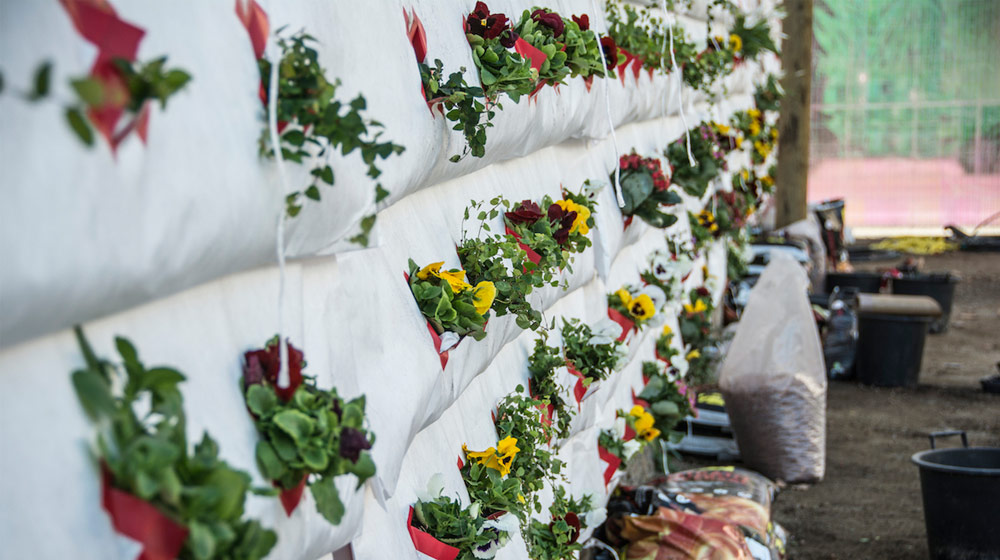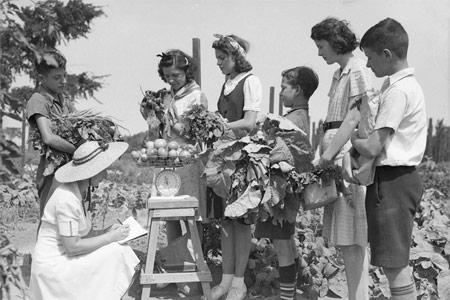After the End of the World
City Station
Environmental Health Clinic in the District of Sant Martí of Barcelona
City Station is set in the proposal by the engineer and artist Natalie Jeremijenko and is the base for her Environmental Health Clinic in the public space of the city of Barcelona, in the Passatge Trullàs (District of Sant Martí). The Station consists of a series of infrastructures to carry out participatory actions in which the city’s people contribute actively to improving environmental health.
Activity takes the form of a series of recipes related to improving soil and air quality, or increasing greenery and biodiversity, among other things. With the emphasis on the collective research and public participation that characterise citizen science, the Station has the support of the scientific community and local bodies and organisations. The Oficina de Ciència Ciutadana (Citizen science office) of the Institut de Cultura de Barcelona is also contributing to the project, particularly in the form of the International School of Citizen Science, with researchers from all over the world taking part in this collective effort.
Workshops
Visitors to City Station will be able to take part in as many as 16 workshops. Prior registration is required to take part from Monday to Friday. At the weekend, they will be open to the public. Opening times will soon be posted on the web for consultation.
Plants in the city and health
↑Recipe by Dr Anna Rigol, Dr Sara Cabrero, Dr Jacqueline Estévez, Dr Oriol Ramírez-Guinart and Dr Miquel Vidal
Urban Flora and Allergies, Aerobiological Information Point, Institut de Ciència i Tecnologia Ambientals (ICTA-UAB)
There are plants in cities. Some of these plants, which we call ornamentals, are selected by gardeners and found in parks, squares and streets. These plants are chosen to make our surroundings more attractive, offer shade, and provide food and/or shelter to animals. Other plants grow spontaneously where the soil is fertile enough or has no other assigned use. Cities have to have plants—the more varied the better—but when we choose which species to grow, we have to make sure they don’t interfere negatively. One aspect to be taken into account is health and, more specifically, the allergies that some citizens suffer from.
Adding biochar to urban soils: improving soil quality
↑Recipe by Dr Teresa Sauras and Dr Núria Roca
Analytical Chemistry Section, Department of Chemical Engineering and Analytical Chemistry, Faculty of Chemistry, University of Barcelona
Good quality urban soil in cities is vital to creating leafy green areas that help to improve the population’s health by renewing the air and with their therapeutic role for people. Urban soil, often affected by industrial activities, tends to be compacted, which means it has little capacity for retaining the water and nutrients needed for plants to grow properly, and may even contain pollutant substances such as heavy metals. This issue is particularly acute in Poblenou, a former factory area, but it also extends to other parts of the city.
Adding biochar to urban soils: improving plant growth
↑Recipe by Dr Teresa Sauras and Dr Núria Roca
Plant Physiology Section, Department of Evolutionary Biology, Ecology and Environmental Sciences, Biology Faculty, University of Barcelona
Urban soils are emerging ecosystems that offer the chance to create new natural spaces in cities. Often, however, they are degraded soils, of low environmental quality for vegetation to develop properly, and actions are needed to restore soil functions (ecosystem services) such as supplying water and nutrients to plants.
Digital leaf area count
↑Recipe by Dr Shawn C. Kefauver and Dr Adrian Gracia Romero
Mediterranean Crop Ecophysiology Group, Department of Plant Physiology, University of Barcelona
The amount of green in the city is based not on its green areas but on leaf area index, or LAI. According to the COP 21 agreement, it is necessary to significantly increase greenery in the city. Increasing greenery means not just improving air quality; it also influences other climatic factors related to our health. We’ll be analysing the leaf area index of parks and gardens or any other green area in the city using a cell phone and other digital tools. Recipe recommended recipe for participants of 13 years and over.
Analog leaf area count
↑Recipe by Dr Shawn C. Kefauver and Dr Adrian Gracia Romero
Mediterranean Crop Ecophysiology Group, Department of Plant Physiology, University of Barcelona
We want to collect information about the amount of green in our urban environments. We’ll be analysing the low-level green surface (lower than 1.5 metres) in parks and gardens or any other green area in the city using materials that we have at our disposal and almost without any digital devices.
Leaf area count in vertical gardens
↑Recipe by Dr Shawn C. Kefauver and Dr Adrian Gracia Romero
Mediterranean Crop Ecophysiology Group, Department of Plant Physiology, University of Barcelona
Vertical gardens are a good way to increase green in the city without having to occupy horizontal surfaces. The leaf area index can be significantly increased in keeping with the requirements of the COP 21 agreement for cities. The action improves air quality and other climate factors related to health. The recipe quantifies the increase in greenery in vertical gardens using digital devices. Recipe recommended for participants of 13 years and over.
Urban spaces and their uses
↑Recipe by Dr Pablo Knobel Guelar
Conservation, Biodiversity and Global Change Group, Institut de Ciència i Tecnologia Ambientals (ICTA-UAB)
Urban spaces (particularly green urban spaces) are key elements in the design of any city and provide unique contexts for conducting certain activities. But not all spaces are the same: each one has its own characteristics, which means that each space has a different use. Understanding the factors that define the characteristics of spaces and their use can be of vital importance for future studies of the role of green urban spaces and city design.
Reducing contamination by recycling
↑Recipe by Dr Jordi Pietx i Colom and Dr Esther Garcia
ECOEMBES
Imagine the entire process of manufacturing a container from scratch, including the sourcing of raw materials. Now think about how this process can be reduced if we use recycled materials. The difference is major savings in water, energy and, therefore, CO2 emissions that are no longer released into the atmosphere. We want to quantify the benefits for one citizen of recycling metal cans and plastic containers for a week.
Ornithological biodiversity during the nesting period
↑Recipe by Dr Abel Julien
Nests Project and the Institut Català d’Ornitologia
Studies in Barcelona show that the city has some interesting bird life in both quality and quantity. In winter and in the migration season, Barcelona's parks attract a large number of birds of varying species. During the breeding season, however, many species are absent, despite the fact that the habitat apparently covers their food needs. Generally, the reason is that there are insufficient nesting sites, such as holes, shrubs, trees or rocky land. This project aims to do something about it!
Monitoring ornithological biodiversity in gardens
↑Recipe by Dr Abel Julien
Nests Project and the Institut Català d’Ornitologia
Cities also host biodiversity, especially in green areas. Studies in Barcelona show that the city has some interesting bird life in both quality and quantity. The ICO’s Garden Birds project monitors the birds we see in public and private gardens to obtain information that helps us to diagnose the health of bird populations in humanised environments.
The colours of carbon dioxide
↑Recipe by Dr Laia Pellejà and Dr Fernando Gomollón-Bel
Institut Català d’Investigació Química (ICIQ)
The amount of carbon dioxide in the atmosphere has increased exponentially in the last 200 years. CO2 is one of the main causes of climate change. It is also responsible for the acidification of the oceans, because when dissolved in water it is transformed into carbonic acid (like in soft drinks), and this can harm marine ecosystems. We will discover how CO2 acidifies water when it is dissolved, using pH strips that change colour in contact with the water.
Solar cells powered by vegetables
↑Recipe by Dr Laia Pellejà and Dr Fernando Gomollón-Bel
Institut Català d’Investigació Química (ICIQ)
We need to find an efficient, renewable energy source to meet today’s electricity demand. One of the best solutions is to use the light provided by the sun, and this is possible using solar cells of different materials. We can “copy” plants and use organic compost (such as chlorophyll or carotenes) that are capable of transforming sunlight into energy. We’ll be making solar cells using products we can buy at the supermarket, like vegetables and spices. The solar cells will produce enough energy to turn on a light-emitting diode (LED).
Lemon-flavoured batteries
↑Recipe by Dr Laia Pellejà and Dr Fernando Gomollón-Bel
Institut Català d’Investigació Química (ICIQ)
Batteries are based on chemical reactions. To be efficient, they normally use materials such as lithium, lead or cadmium. But we can also make electricity using everyday materials and in a clean, sustainable way. We’ll be making batteries from everyday materials that are capable of generating enough energy to light small electrical devices such as LEDs, watches or calculators.
Following the rhythms of nature
↑Recipe by Dr Joan Masó, Dr Ester Prat, Dr Joan Pino, Dr Corina Basnou, Dr Alberto Masa, Dr Ester Manzano, Dr Iñigo Lamsfus, Dr Cristina Montachini, Dr Camille Pelloquin and Dr Uta When
Ground Truth 2.0, CREAF, Altran, Starlab, IHE-Delft
Phenology is the observation of seasonal changes in plants and animals, such as flowering, the appearance of insects, and bird migration. The changing rhythms of nature give scientists a lot of information about the effects of climate change on natural ecosystems, but they need ongoing, standardised, validated series of data distributed geographically across the entire territory. Nature-loving citizens are needed who want to learn to make phenological observations and help scientists study the impacts of climate change on plants, animals and living organisms in general.
Energy self-consumption
↑Recipe by Dr Albert Tarancón, Dr Víctor Izquierdo and Dr Teresa Andreu
Advanced Materials for Energy Department, Institut de Recerca en Energia de Catalunya (IREC)
Some 75% of the world’s energy is consumed in cities, even though the urban population is just over 50% of the total. Coming up with habits for a more efficient use of energy in the urban environment and showing the possibilities of renewable energy resources in cities are vitally important to improving the quality of the air we breathe.
Credits
City Station is a coproduction of the CCCB and the Institut de Cultura de Barcelona, the Department of Ecology, Urban Design and Mobility of Barcelona City Council, and the District of Sant Martí. With the collaboration of Taula Eix Pere IV.
Environmental Health Clinicx Barcelona is a project by: Natalie Jeremijenko
Curatorship: Josep Perelló
Direction: Amanda Masha Caminals
Space design: Guillermo Santomà
Space production: Torrecilla Espais
This activity is part of After the End of the World
Related contents
Next Stop: City Station
Núria Jar
The exhibition “After the End of the World” spread out over the city of Barcelona through diverse citizen science actions that aimed to improve the city’s environmental health. Núria Jar, journalist who specialises in science and health, writes about the initatives ...

